Wood Destroying Beetle Control
Wood-Boring Beetles: The Tiny Terrors of Timber!
Think termites are the only wood destroyers? Think again! Wood-boring beetles are stealthy invaders that tunnel deep into wood, leaving behind tiny exit holes, powdery frass (wood dust), and plenty of frustration. From antique furniture to hardwood floors and structural beams, these pests can turn solid wood into a fragile mess before you even notice them! Whether it is anobiid powderpost beetles, or western deathwatch beetles, these wood-hungry intruders can cause serious damage over time.
Don’t let these beetles bore their way into your home or business—call us today for expert identification and treatment before they turn your investment into sawdust!
Wood-Boring Beetle Control & Prevention
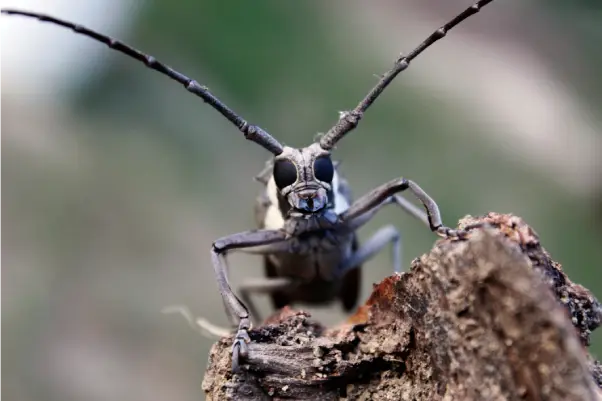 Wood-boring beetles may not bite, sting, or spread disease, but they can silently destroy wooden structures, furniture, and trees. These pests lay their eggs in wood, and as their larvae tunnel through, they create hidden damage that can weaken beams, flooring, and other wooden materials if left untreated.
Wood-boring beetles may not bite, sting, or spread disease, but they can silently destroy wooden structures, furniture, and trees. These pests lay their eggs in wood, and as their larvae tunnel through, they create hidden damage that can weaken beams, flooring, and other wooden materials if left untreated.
Thorough Site Inspection
- Our wood-boring beetle control process starts with a detailed inspection, identifying species based on emergence hole size, frass (wood dust), and wood characteristics.
- Since these beetles often remain hidden inside wood, we assess key infestation indicators to determine whether treatment is necessary and create a customized plan for effective control.
Effective Control & Treatment
- Our treatment strategy targets both active infestations and re-infestation risks.
- We treat effected wood surfaces, eliminating emerging adult beetles and preventing future larvae development.
Long-Term Prevention & Protection
- Routine inspections and proactive professional applications help prevent future infestations.
- We provide referrals to ensure you are partnered with industry experts to provide guidance on moisture control, ventilation improvements, and proper wood maintenance to make your property less inviting to wood-boring beetles.
Professional Wood-Boring Beetle Control Services
Proper identification is essential as while some wood-boring beetles pose no threats, others can cause devesating damages to wooden structures. Over time, their larvae tunnel through wood, weakening beams, flooring, and furniture, which can lead to costly repairs.
Our comprehensive beetle control services focus on:
- Eliminating active infestations before they cause further structural damage.
- Preventing re-infestation with targeted treatments and moisture control solutions.
- Minimizing long-term beetle activity by addressing conducive conditions.
With a strategic, science-backed approach, we ensure your property remains protected from wood-boring beetle damage. Schedule an inspection today and safeguard your home or business from these destructive pests!
- Quarterly & Bi-Monthly Programs
- Target Pests: Ants, spiders and various other crawling insects
-
Service Includes:
- Exterior perimeter inspection and application for crawling insect control
- Removal of accessible wasp nests on the structure of your home
- Sweeping of spider webs followed by an overhead application for spider control
- Interior services as needed
- Quarterly & Bi-Monthly Programs
- Target Pests: Rats, mice, ants, spiders and various other crawling insects.
-
Service Includes:
- Exterior perimeter inspection and application for crawling insect control
- Removal of accessible wasp nests on the structure of your home
- Sweeping of spider webs followed by an overhead application for spider control
- Service exterior rodent bait stations and inspect for potential entry points
- Interior services as needed
- Quarterly & Bi-Monthly Programs.
- Target Pests: Rats & Mice.
-
Service Includes:
- Exterior perimeter inspection for potential entry points, nesting areas or food sources.
- Seal up identified entry points to prevent the rodents from accesses the interior of your home.
- Service exterior and interior rodent bait stations.
- Interior services as needed.
Identification
Wood-Boring Beetle Identification
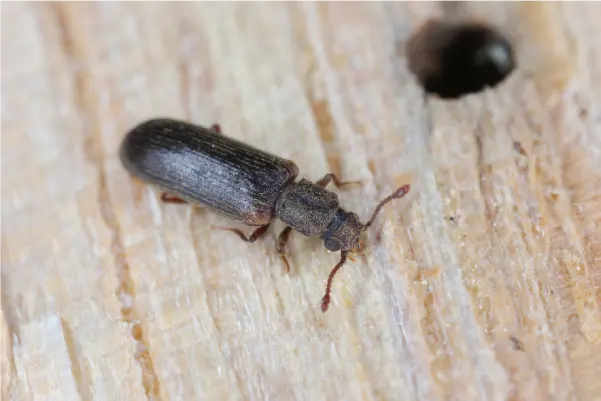 Wood-boring beetles come in many shapes and sizes, but they all have one thing in common—their larvae tunnel through wood, feeding as they grow. The most common types of wood-boring beetles in the Pacific Northwest regions include:
Wood-boring beetles come in many shapes and sizes, but they all have one thing in common—their larvae tunnel through wood, feeding as they grow. The most common types of wood-boring beetles in the Pacific Northwest regions include:
- Lyctid Beetles (True Powderpost Beetles) – Typically infect wood items less than 5 years old and primarily infest hardwoods such as flooring, trim, furniture, and cabinetry.
- Anobiid Beetles (False Powderpost Beetles or Deathwatch Beetles) – Attack older wood items, prefers softwoods, thrive in crawlspaces and basements with high moisture and is responsible for most of the beetle-related damage to wooden structures along our coastal areas.
- Buprestid Beetles (Flat-Headed Borers) – Often found in firewood, logs, and trees but typically do not reinfest.
- Cerambycid Beetles (Round-Headed Borers) – Attack both hardwood and softwood, with some species capable of reinfesting structures.
How Wood-Boring Beetles Infest Wood
Most wood-boring beetles begin their life cycle when a female lays eggs on the bark of dead or dying trees. Once the eggs hatch, larvae bore into the wood and slowly feed, grow, and tunnel—sometimes for years—before emerging as adults.
Do Wood-Boring Beetles Pose a Threat to Your Home?
Some species do not reinfest wood after emerging as adults, meaning they cause limited damage, while others can reinfest and continue to destroy wood over time.
✔ Minimal Risk Beetles – No Reinfestation
○ False Powderpost Beetles
○ Flat-Headed Wood Borers
○ Ambrosia Beetles
✔ High Risk Beetles – Capable of Reinfestation
○ True Powderpost Beetles
○ Deathwatch Beetles
○ Round-Headed Borers
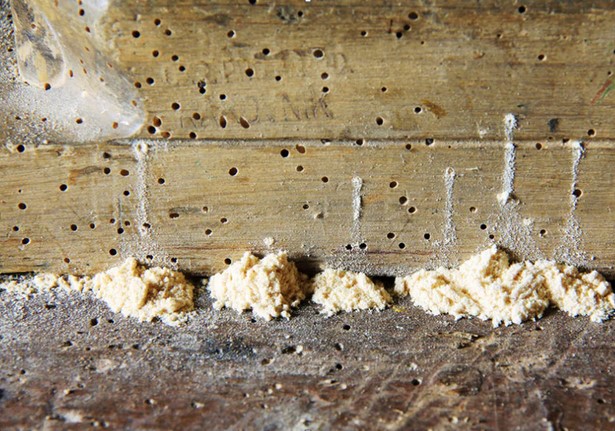 Signs of a Wood-Boring Beetle Infestation
Signs of a Wood-Boring Beetle Infestation
- Small, circular exit holes in wood surfaces
- Fine, powdery frass (wood dust) beneath infested areas
- Hollowed or weakened wood that crumbles easily
- Tunnels or galleries visible inside the wood when cut open
Not Sure What You’re Seeing? We Can Help!
If you notice holes, frass, or suspect beetle activity, contact us for expert identification and treatment options. Our team will determine if corrective action is needed and help protect your home or business from further damage.Risks
The Hidden Dangers of Wood-Boring Beetle Infestations
Wood-boring beetles cause the most damage during their larval stage, silently tunneling through wood as they feed. However, the true threat lies in their ability to reinfest—some species can reproduce within the same wood, allowing infestations to persist and worsen over time.
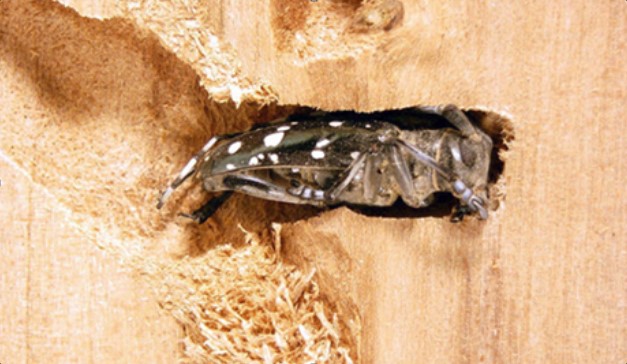 How Long Can Wood-Boring Beetles Stay Active?
How Long Can Wood-Boring Beetles Stay Active?
- Some species develop into adults within a year, quickly emerging to start a new generation
- Others can remain in the larval stage for over 20 years, continuously feeding on wood if conditions allow
- The severity of damage depends on whether the beetles reinfest after emerging as adults
Why Crawlspaces Are a Hotspot for Infestation
- The majority of wood-boring beetle infestations occur in crawlspaces, where damp conditions make wood more vulnerable
- High moisture levels in crawlspaces create the perfect breeding ground for beetles, encouraging reinfestation and prolonged wood destruction
- The #1 cause of significant beetle damage? A missing or improperly installed vapor barrier, which allows moisture from the soil to saturate the air and wood, attracting pests.
Protect Your Property Before Damage Escalates
Since wood-boring beetles stay hidden inside wood for most of their lifecycle, infestations can go unnoticed for years. If you suspect beetle activity or have moisture issues in your crawlspace, call us today for an expert inspection and customized treatment plan!
Wood-Boring Beetle Control Methods
Wood-boring beetle infestations require a customized approach, as treatment options depend on the extent of the infestation, species involved, and condition of the wood. The most effective strategy focuses on eliminating active infestations while preventing future beetle activity.
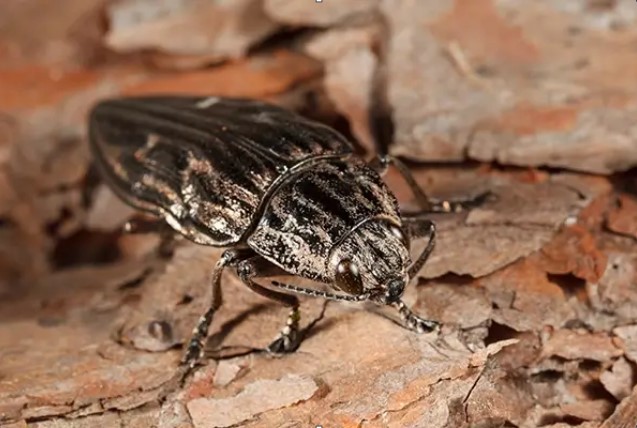 Surface Treatment with Insecticide
Surface Treatment with Insecticide
- The primary treatment method involves applying a residual insecticide to exposed, untreated wood.
- For this treatment to be effective, the wood must be free of paint, stain, or sealant. If the wood has been previously sealed, it must be sanded down to bare wood so the treatment can fully penetrate.
- In cases where damage is extensive, replacing the affected wood may be a simpler and more effective solution.
Identifying the Right Treatment Approach
- Wood-boring beetles share similar characteristics, but not all species behave the same way. Since beetles remain hidden inside wood during most of their life cycle, identification is based on key indicators, including:
- Size and shape of emergence holes left behind by adult beetles
- Type of wood affected (hardwood vs. softwood)
- Moisture content of the infested wood
- Frass (wood dust) characteristics and beetle activity patterns
Once we accurately determine the species—and whether it’s a reinfesting type—we can develop a targeted control plan to eliminate the infestation and protect your home or business from further damage.
If you suspect wood-boring beetle activity, contact us today for a professional assessment and customized treatment plan!
Prevention Tips
Prevention Tips for Wood-Boring Beetles
Wood-boring beetles can cause significant damage to homes, furniture, and trees if left unchecked. Prevention starts with proper wood selection, sealing, moisture control, and regular inspections to minimize the risk of infestation. Key prevention methods include:
Choose the Right Wood –
When building or purchasing furniture, opt for treated or well-seasoned lumber to reduce beetle attraction.
Seal & Paint Exposed Wood –
Apply a protective paint, stain, or sealant to exposed wood surfaces to prevent beetles from laying eggs.
Control Moisture Levels –
Ensure proper ventilation in crawl spaces, attics, and other moisture-prone areas to discourage beetle activity.
Regular Inspections –
Periodically check wooden structures, furniture, and firewood for signs of beetle activity, such as:
✓ Small, round exit holes.
✓ Fine, sawdust-like frass (wood dust).
✓ Presence of adult beetles.
Tree Selection & Pruning –
Choose tree species less prone to wood-boring beetles in your region and regularly prune trees to remove dead or damaged branches, which can attract beetles.
Firewood Management –
Store firewood away from your home and only bring in small quantities as needed to avoid introducing beetles indoors.
By implementing these preventative measures, you can greatly reduce the risk of wood-boring beetle infestations in your home and landscape. For expert advice and treatment options, contact us today!

